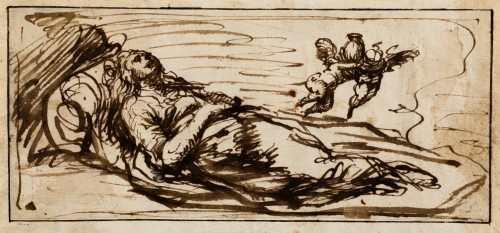Spanish Old Master Drawings
The Death of Mary Magdalen
Alonso Cano
(Granada, 1601-1667)
- Date: c. 1645-1650
- Pen and grey-brown ink on laid paper
- 90 x 192 mm
- Provenance: Madrid, private collection
Literature: Navarrete, Benito: "Nuevos dibujos de Alonso Cano y su círculo", Archivo Español de Arte, no. 296, 2001, p. 438, fig. 5; Véliz, Zahira: Alonso Cano [1601-1667]. Dibujos. Catálogo razonado. Santander, Fundación Botín, 2011, p. 420, cat. no 91
This very small sketch, executed in pen and grey-brown ink, is a masterly example of the expressive and narrative powers achieved by Alonso Cano at the height of his artistic powers. Using rapid, zig-zagging strokes of different thicknesses for the background and figures, the artist creates a symphony of curved and straight lines through which he depicts the figure of a woman lying on a bed, holding a cross and with her head resting on a pillow at the moment of her death. In an almost magical way, Cano conveys the silence of the space and the peace of the figure as she yields to the final moments of her earthly life. Next to her on the right are a pair of winged figures that suggest small angels, indicating that this is not an everyday scene but rather an episode with a religious content. In addition, the fact that the angels have small haloes over their heads suggests that the recumbent figure is a saint. Within the context of religious iconography, a peaceful deathbed episode of this type generally refers to one of two female figures.
read more
The first is the Virgin Mary in the so-called “Dormition of the Virgin”, which is the moment of the glorification of the Virgin’s body and soul as both ascend together to heaven and in which the Virgin’s body is surrounded by the Apostles, as depicted in the painting by Andrea Mantegna (MNP, P-00248). The other female figure shown at the moment of her death is Mary Magdalen. According to Jacopo de Voragine, after retiring to a cave where she lived apart from the world for thirty years, the Magdalen died and was borne by angels to the oratory of Saint-Maximin in Aix-en-Provence. At the moment of her death her face shone in such a way that “any person would have more easily endured the sun’s rays on their eyes than the brilliant glow emanating from that face.” 1 While this episode was not as popular as that of the penitent Mary Magdalen, it was among those employed in the Baroque period to depict this saint. Examples include the small sculptural group by Luisa Roldán in the Hispanic Society of America in New York (fig. 1, inv. no. D822) and the drawing by Juan Niño de Guevara, on the same subject, in the Uffizi (fig. 2, MNP, inv. no. 10420S). The sole presence of angels in the present sketch and the figure’s gesture of seemingly taking her last breath thus suggest that the subject is The Death of Mary Magdalen, an opinion expressed by Benito Navarrete and seconded by Zahira Véliz, expert on Alonso Cano’s drawing. 2 Nonetheless, it would appear that this initial sketch was not used for a final canvas or at least not one currently known given that there are no known works on this subject by the artist.
With regard to the drawing’s date, the rapidity and deftness of the technique relate it to other pen studies by the artist executed between 1645 and 1650. They include Figure Study and Venus, Cupid and a Satyr, both in the Uffizi (inv. nos. 10254S and 10260S), 3 and the Figure of a male or female Saint presented in this catalogue, of which the technique and size are very comparable to the present work. In addition, the small angels on the right are similar to those in the lower part of The Triumph of Apollo in the Biblioteca Nacional in Madrid (sign. DIB/15/21). 4 This drawing can thus be considered a work from Cano’s mature period, executed during his time in Madrid. It is interesting to note that just before those years, in 1644, the artist’s wife, María Magdalena de Uceda, was murdered. Cano was accused of the crime and was tortured to extract a confession from him, although he was finally acquitted. While the present sketch can naturally not be associated with that event, the emotion and silence that fills the scene seems strikingly real. Furthermore, despite being very summarily depicted, the figure’s face has notably specific features.
- Vorágine (1982), vol. I, p. 389.
- See Navarrete (2001), p. 438, fig. 5 and Véliz (2011a), p. 420.
- Véliz (2011a), pp. 414 and 424, cats. 89 and 93.
- Véliz (2011a), p. 430, cat. 96.


